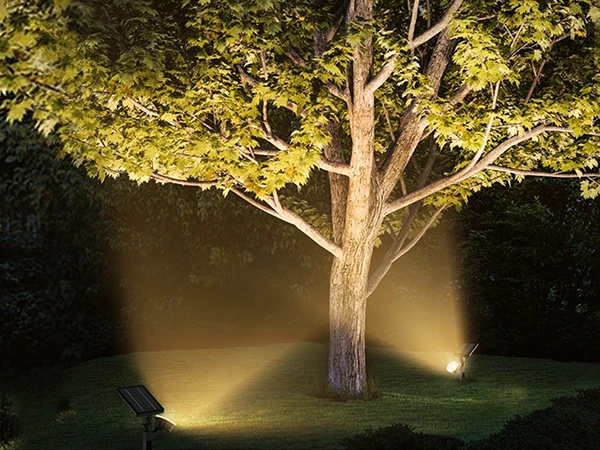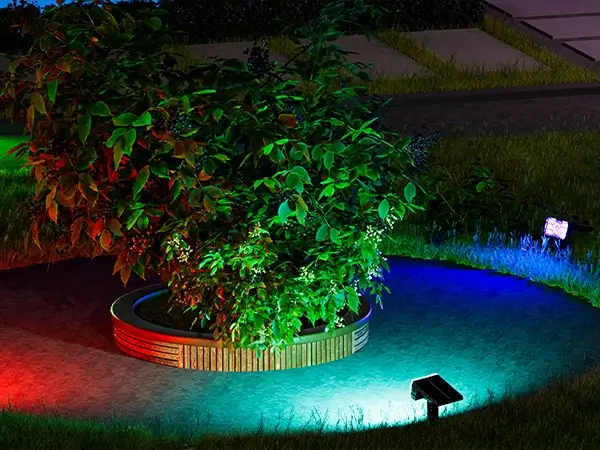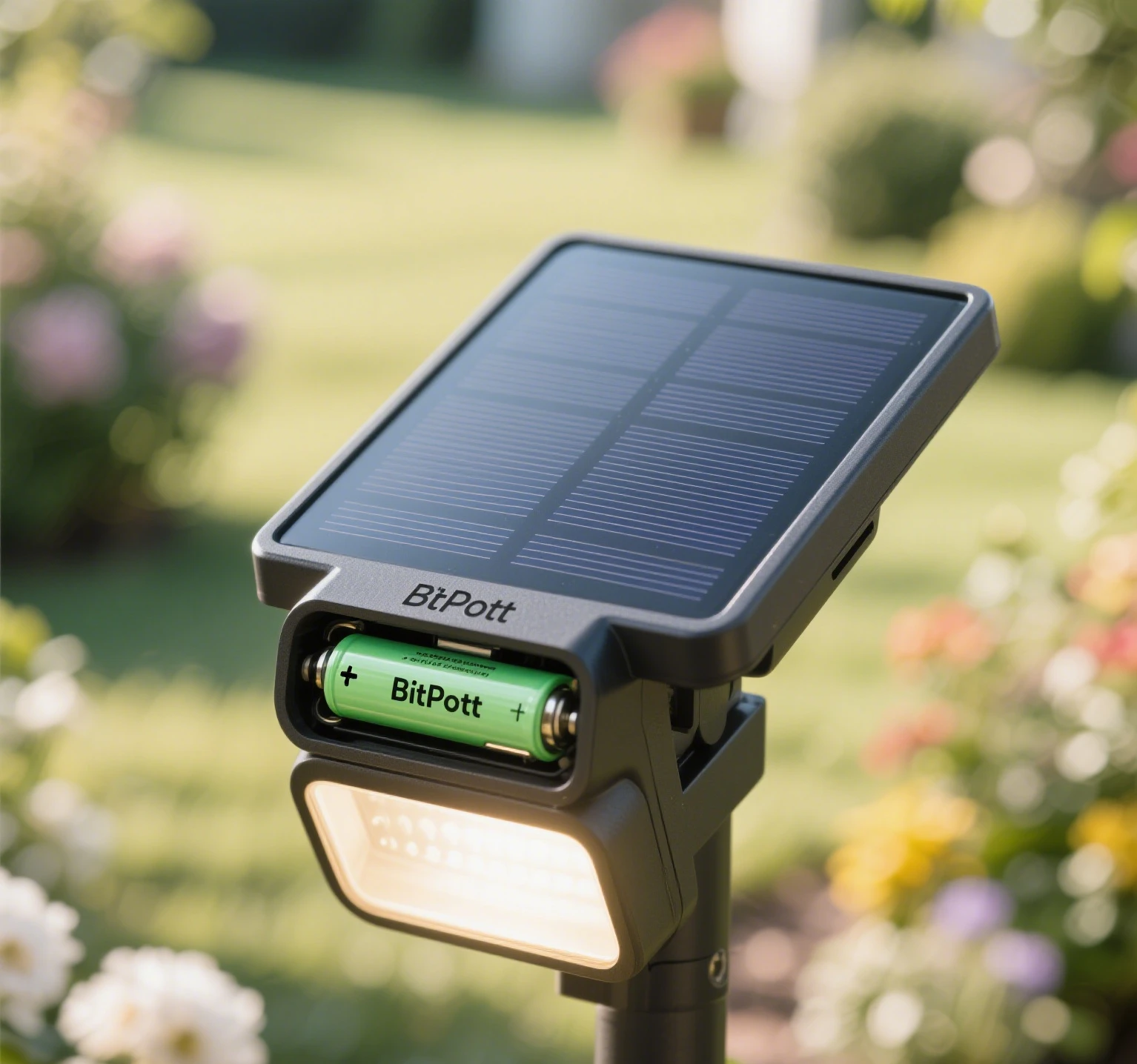As a North American sustainability enthusiast, you’ve likely noticed how a well-placed solar spotlight makes your pothos lusher or your roses more vibrant. It’s not just aesthetics—light can boost plant growth, while plants make your lighting design pop. This synergy is the heart of sustainable gardening. By using solar spotlights and garden lights, you can create a yard where plants thrive and lights shine, all while keeping your eco-footprint light. Written from the perspective of a gardening blogger and eco-advocate, this guide shows you how to choose plant-friendly solar lights, design a yard where plants and light enhance each other, and prioritize sustainability. Let’s create a garden that’s as green in practice as it is in color.

The Magic of Light and Plant Symbiosis
Light does more than illuminate—it fuels photosynthesis, helping plants grow stronger and healthier. Solar spotlights with red and blue LEDs mimic the sun’s spectrum, giving your plants the wavelengths they crave. Meanwhile, plants like towering trees, blooming flowers, or delicate succulents act as natural canvases, reflecting and softening light to create a stunning visual effect. This mutual enhancement—light promoting growth, plants amplifying beauty—is perfect for sustainable gardeners in North America, where long summer days and diverse climates offer endless possibilities. Whether you’re tending a small urban plot or a sprawling suburban yard, solar lighting lets you nurture both plants and the planet.
Choosing Plant-Friendly Solar Lights
To boost plant growth, select solar lights with specific light spectra and brightness levels tailored to your garden’s needs. Here’s a breakdown of what works best:
- Red and Blue LED Spotlights for Photosynthesis:
Plants thrive on red (620–630nm) and blue (450–460nm) light, which drive photosynthesis and growth. Solar spotlights with red-blue LED options are ideal for most garden plants. For succulents, aim for 150 lumens to encourage compact, vibrant growth. For flowering plants like roses or lavender, go for 200 lumens to support budding and blooming. Time these lights to shine from 5:00 PM to 8:00 PM, supplementing natural daylight without disrupting plant sleep cycles. Example: GIGALUMI Solar Spotlights with Color Modes (200 lumens, adjustable spectrum). - Garden Lights for Ground Cover:
Low-profile solar garden lights (50–100 lumens, warm white 2700K) work well for ground-cover plants like hostas or ferns. These provide gentle illumination without overwhelming delicate foliage. Choose models with adjustable stakes to position at soil level. Example: Beau Jardin Solar Garden Lights (8-pack, 100 lumens). - Waterproof Decorative Lights for Water Features:
For hydroponic setups or water gardens, use waterproof solar decorative lights (IP65 rating or higher). These can sit near water features or hydroponic trays, casting soft light (20–50 lumens) to highlight water plants like lotus or water lilies. Example: LINKIND Solar Floating Lights (50 lumens, waterproof). - Key Specs to Look For:
- Light Spectrum: Red (620–630nm) and blue (450–460nm) for growth; warm white (2700–3000K) for aesthetics.
- Brightness: 150 lumens for succulents, 200 lumens for flowering plants, 20–100 lumens for decorative or ground lighting.
- Timing: 3–4 hours of evening light (5:00–8:00 PM) to extend daylight without overexposure.
- Durability: IP65 or higher for weather resistance in North American climates (rain, snow, or heat).
These lights ensure your plants get the right light at the right time, tailored to North America’s varied growing seasons.
Designing a Garden Where Plants and Light Shine
A sustainable garden isn’t just functional—it’s beautiful. By strategically placing solar lights, you can highlight your plants’ best features while letting their textures and colors enhance the light’s effect. Here’s how to design for this symbiosis:
- Spotlights on Trees and Shrubs:
Use solar spotlights to uplight tree trunks or shrub branches, creating dramatic silhouettes. Position lights 1–2 meters from the base, angled upward at 30–45 degrees to graze the bark or foliage. This highlights the plant’s structure while casting soft shadows that add depth. For example, a 200-lumen spotlight on a maple tree’s trunk makes its textured bark glow, enhancing the yard’s evening charm. Example placement: One spotlight per large tree or shrub, spaced evenly for balance. - Garden Lights Hidden in Flower Beds:
Tuck low-profile solar garden lights among flower beds or ground cover like petunias or marigolds. Place them 1–2 feet apart, with the light just above soil level to blend into the foliage. The warm glow makes flowers pop without overpowering their colors. This setup also guides evening strolls, combining practicality with beauty. - Decorative Lights for Hydroponics or Water Gardens:
Place waterproof solar lights near water features or hydroponic setups to reflect off water surfaces, creating a serene effect. For example, a floating solar light in a pond with water lilies adds a magical glow, while a small light near a hydroponic basil tray highlights its lush leaves. Ensure lights are fully submersible or splash-proof for safety. - Design Tips:
- Layering: Combine spotlights (high), garden lights (low), and decorative lights (mid-level) for a balanced, three-dimensional effect.
- Color Harmony: Use warm white for aesthetics and red-blue for growth, avoiding harsh cool white tones.
- Plant-Light Pairing: Match light intensity to plant type—brighter for flowers, softer for succulents or water plants.
- Solar Panel Placement: Position panels in south-facing, unshaded areas for 6–8 hours of daily sunlight, common in North American yards.
This approach creates a garden where light and plants work together, each making the other more vibrant.

Sustainable Practices: Eco-Friendly Lighting Choices
Sustainability is at the core of this design. Solar lights already save energy, but you can go further by choosing eco-conscious materials and practices:
- Recyclable Lamp Bodies:
Opt for solar lights made from recyclable materials like aluminum or ABS plastic. Brands like Solpex and LITOM label their products as recyclable, ensuring you can dispose of them responsibly at the end of their lifespan (typically 3–5 years). Check local recycling programs for electronics drop-off points. - High-Efficiency Solar Panels:
Choose lights with monocrystalline solar panels, which convert sunlight at 20–22% efficiency (higher than polycrystalline at 15–17%). These charge faster and perform better in cloudy North American regions like the Pacific Northwest. Look for panels with a wattage of 2–5W for spotlights and 0.5–1W for garden lights. - End-of-Life Recycling:
When replacing lights, disassemble them for recycling:- Remove Batteries: Most solar lights use NiMH batteries. Take these to a battery recycling center (e.g., Home Depot or Best Buy in the U.S.).
- Separate Components: Detach plastic, metal, and glass parts. Check with your local waste facility for proper disposal.
- Donate Working Lights: If upgrading, donate functional lights to community gardens or neighbors to extend their life.
These choices ensure your garden aligns with sustainable living principles, reducing waste and maximizing efficiency.
Installation Guide for Your Eco-Garden
Setting up your solar lighting system is a weekend project that blends science and creativity. Follow these steps for a thriving, well-lit garden:
- Plan Your Layout (30 Minutes):
Walk your garden at dusk to identify key plants (trees, flowers, hydroponics) and sunny spots for solar panels. Sketch a layout, noting where spotlights, garden lights, and decorative lights will go. Ensure south-facing panel placement for optimal charging. - Install Growth-Boosting Lights (1–2 Hours):
- Spotlights: Stake or mount spotlights 1–2 meters from trees or shrubs, angled to hit trunks or foliage. Set to red-blue mode (if adjustable) for 5:00–8:00 PM.
- Garden Lights: Insert stakes into flower beds, spacing 1–2 feet apart. Adjust height to sit just above plants.
- Decorative Lights: Place near water features or hydroponic setups, ensuring waterproof models are secure.
- Test and Adjust (30 Minutes):
After a day of charging (6–8 hours of sunlight), check lights at night. Adjust angles to optimize plant illumination or aesthetic effect. Use a timer (if available) to limit light to 3–4 hours. - Maintain for Longevity (Ongoing):
Clean solar panels monthly with a damp cloth. Check battery performance annually and replace if dimming occurs. Store lights indoors during harsh winters (e.g., Midwest or Northeast U.S.).
Budget and Sourcing for North America
You can create this eco-garden for $100–$150, depending on size. Here’s a sample budget:
- Red-Blue LED Spotlights: $40 for 4-pack (e.g., GIGALUMI Solar Spotlights, 200 lumens).
- Garden Lights: $30 for 8-pack (e.g., Beau Jardin, 100 lumens).
- Decorative Waterproof Lights: $30 for 2-pack (e.g., LINKIND Floating Lights, 50 lumens).
Shop at Amazon, Lowe’s, or Walmart for variety. Look for “red-blue LED” or “recyclable” in product descriptions. Check reviews for battery life and weather resistance, especially for North American climates.
A Garden That Grows and Glows
By blending solar spotlights, garden lights, and decorative lights, you create a garden where light fuels plant growth and plants make light beautiful. Red-blue LEDs help your succulents, flowers, and hydroponics thrive, while strategic placement turns your yard into a nighttime masterpiece. With recyclable materials and efficient solar panels, this setup reflects your commitment to sustainability. Spend a weekend setting it up, and you’ll have a North American garden that’s as eco-friendly as it is enchanting—a true symbiosis of light and life.


Leave a Reply